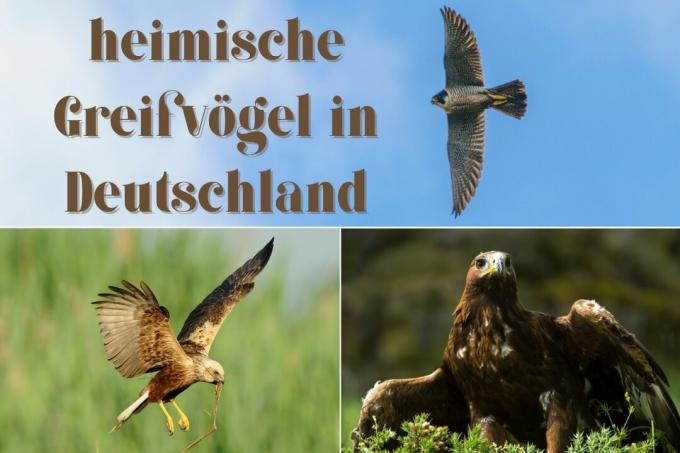
table of contents
- Eagle
- Buzzards
- Hawks and sparrowhawks (Accipiter)
- Kites (milvus)
- Consecration (circus)
- Falcon (falco)
- frequently asked Questions
Birds of prey often exert a special attraction on the observer. They look majestic when circling in the air looking for food. We introduce you to the birds of prey native to Germany.
In a nutshell
- Birds of prey include: ospreys and hawk relatives
- native hawk relatives: other eagles, hawks, harriers and buzzards
- Falconies are not closely related to birds of prey
- Falcons are presented here because of their external resemblance to birds of prey
Eagle
Genus Echte Adler (Aquila) and family Ospreys (Pandionidae)
Eagles are the epitome of the bird of prey, they have very sharp eyes, hunt small mammals out of flight and kill them with a stranglehold with their claws. They nest in large eagle nests made of twigs that are reused over several years. Although two eggs are often laid, often only one young is raised. Two species of these birds of prey are native to Germany.
Osprey (Pandion haliaetus)
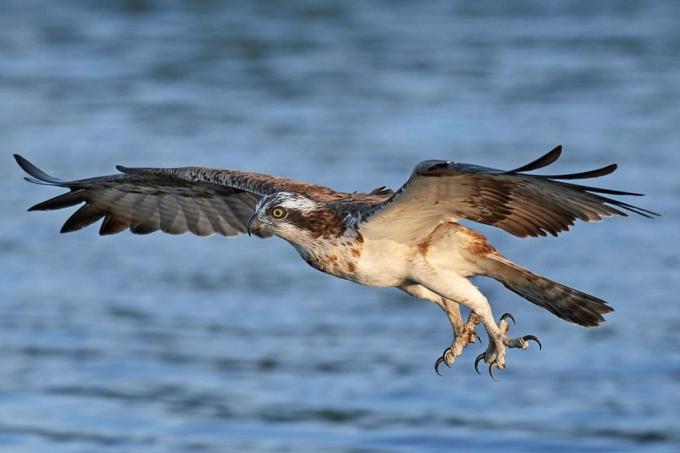
- Length: 55-60 cm
- Wingspan: 150-170 cm
- Weight: 1250-2100 g
- Plumage: upper side dark, mainly brown, underside mainly white, narrow wings, short tail
- Diet: almost exclusively fish, can dive up to 1m deep in a dive
- Distribution: Migratory bird, to be found in Germany in standing and flowing waters
- Reproduction: unlike other eagles, lays more than two eggs, sometimes breeds in colonies
White-tailed eagle (Haliaeetus albicilla)
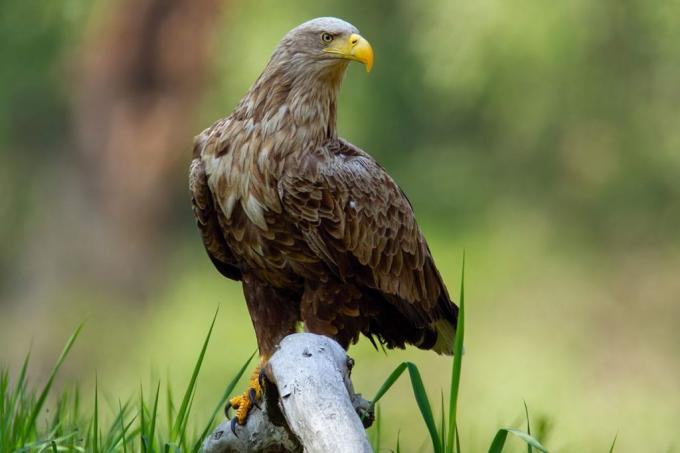
- Length: about 85 cm (female 95 cm)
- Wingspan: around 200 cm (females up to 250 cm)
- Weight: 4100-4600 g (females up to 6900)
- Plumage: body brown, head, neck and chest lighter, tail white
- Diet: mainly fish and birds, but also mammals and carrion
- Distribution: in Germany almost only in the northeast, resident bird
- Propagation: builds clumps in large, old trees, mainly pines and beeches
Note: The predilection for carrion is often fatal for the white-tailed eagle when it eats remains of hunting trips contaminated with lead ammunition and thus poisons itself.
Golden eagle (Aquila chrysaetos)
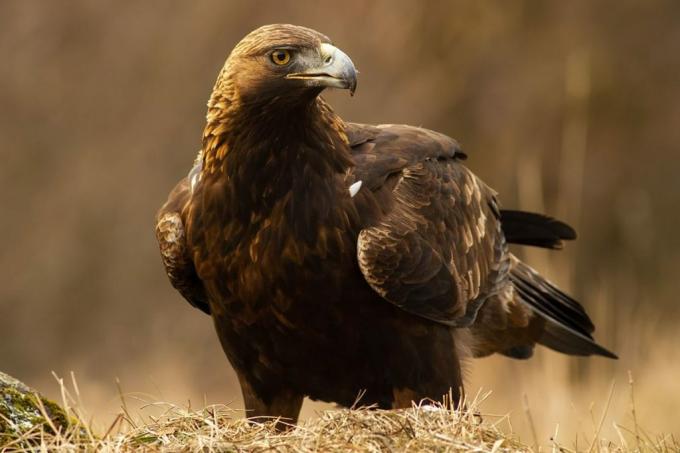
- Length: 75-85 cm, females also larger
- Wingspan: 190-210 cm, females up to 230 cm
- Weight: males up to 4500 g, females up to 6700 g
- Plumage: dark brown, with yellowish nape and whitish underside of wings and tail, tail with black end band
- Diet: mainly mammals, but also birds
- Distribution: in Germany mainly in the Alps, resident bird
- Propagation: nests in rock walls and on tall trees
Buzzards
Genera Common Buzzards (Buteo) and Honey Buzzards (Pernis apivorus)
Buzzards are similar to eagles, but are much smaller and lighter. In contrast to those of the eagle, the legs are predominantly featherless. Small mammals in particular serve as prey, as well as reptiles, carrion, Birds and even earthworms and insects. The honey buzzard is an exception. This native bird of prey specializes in wasps.
Common buzzard (Buteo buteo)
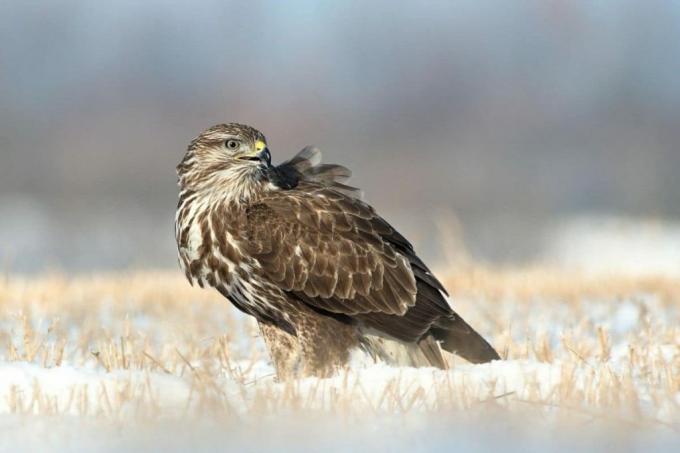
- Length: 48-58 cm
- Wingspan: 115-138 cm
- Weight: 620-1360 g
- Plumage: very variable; almost white to dark brown, grained or uniformly colored, the underside always lighter in color when in flight
- Diet: preferably small rodents (naming!)
- Distribution: most common bird of prey in Germany, distributed almost everywhere, stationary and line bird, from time to time buzzards from Northern Europe overwinter in Germany
- Propagation: builds clumps in trees, but also rocks, is considered a culture follower, therefore also breeds near humans, two to three eggs are laid
Honey buzzard (Pernis apivorus)

- Length: 52-60 cm
- Wingspan: 118-144 cm
- Weight: 510-1050 g
- Plumage: upper side brown, underside also brownish, with lighter grain, wings and tail underside rather gray, head similar to a pigeon, gray in the male, more brownish in the female
- Diet: predominantly wasps or bumblebees, other insects, small invertebrates, frogs and reptiles, rarely also fruit
- Distribution: Migratory bird, overwinters in Africa, breeds in Germany in wooded landscapes
- Propagation: builds mostly heavily green clumps, usually lays two eggs
Hawks and sparrowhawks (Accipiter)
These birds of prey have a slim body shape. Although birds are their main source of food, they also eat small mammals. Representatives of this genus prefer a forest-based way of life.
Goshawk (Accipiter gentilis)
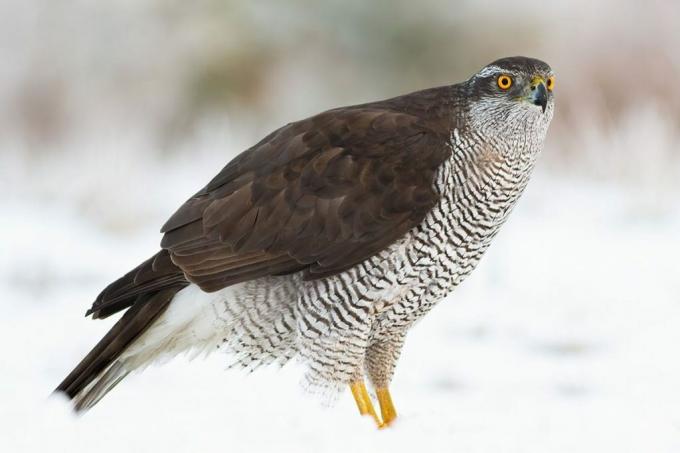
- Length: 50-60 cm
- Wingspan: 110-115 cm
- Weight: 720-1130 g
- Plumage: upper side gray-brown, underside banded white-gray
- Diet: in addition to birds and small mammals, there is rarely also carrion
- Distribution: Standing bird, in Germany in all kinds of forests, most recently also near cities
- Propagation: Horst building in older trees, are often used again, are greened, clutch size between two and three eggs
Sparrowhawk (Accipiter nisus)

- Length: 30-37 cm
- Wingspan: 62-72 cm
- Weight: 140-280 g
- Plumage: male upper side gray-blue, lower side typically sparrowed, color from whitish to orange-red; Females gray-brown on the upper side, creaky underside, predominantly whitish in color, a little orange
- Diet: very agile hunter of small songbirds, also small mammals, reptiles, invertebrates
- Distribution: Standing bird, in open landscapes with conifer populations, very rarely near settlements, in cemeteries, in parks
- Propagation: prefers coniferous trees for building nests, but also takes deciduous trees, lays four to six eggs
Kites (milvus)
Kites are medium-sized birds of prey, the notched tail is typical. They are often sociable and hunt mammals, birds, and fish.
Red kite (Milvus milvus), red kite, fork harrier, king harrier

- Length: 60-73 cm
- Wingspan: 154-170 cm
- Weight: 870-1390 g
- Plumage: predominantly reddish brown, but rich in contrast, head, throat and neck lighter, typical are the forked tail and the white spots on the underside of the hand wings
- Diet: mammals, birds, rarely carrion, waste and fish, invertebrates
- Distribution: predominantly migratory birds, individual animals overwinter in Germany, inhabits open landscapes with stands of trees, such as agricultural areas with hedges
- Propagation: oaks, beeches and pines are preferred for building eyelids; an average of three eggs are laid
Black kite (Milvus migrans), Black kite

- Length: 55-60 cm
- Wingspan: 140-150 cm
- Weight: 630-940 g
- Plumage: predominantly dark brown, not entirely black, few grains, tail not so strongly notched
- Diet: wide range of prey, also eats carrion and slaughterhouse waste
- Distribution: migratory bird, lives in Germany in open landscapes with groups of trees or trees, also near water
- Propagation: Horst structure very different, also takes over clumps of other birds, lays two to three eggs
Note: The black kite is not as common here as the red kite, but is considered the most common bird of prey worldwide.
Consecration (circus)
These native birds of prey are medium-sized and inhabit open landscapes. The construction of ground nests is typical for consecration.
Hen harrier (Circus cyaneus)
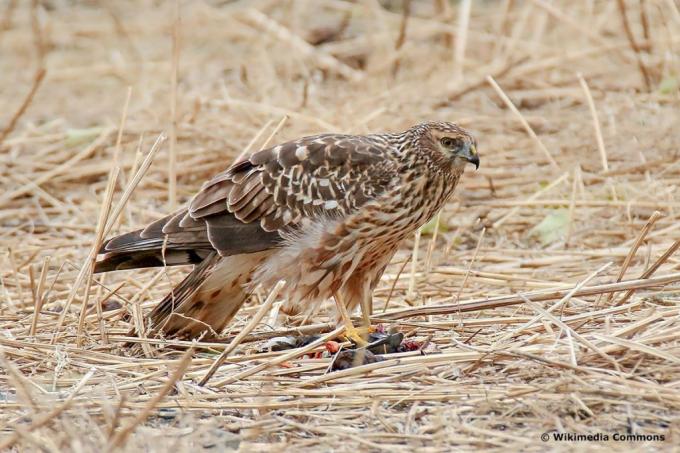
- Length: 43-52 cm
- Wingspan: 100-120 cm
- Weight: 300-600 g
- Plumage: Males upper side, neck, head and chest blue-gray, outer wing black, underside predominantly white; Females upper side medium brown, underside lighter, striped, rump white
- Diet: mammals, birds, reptiles, fish, insects
- Distribution: inhabits moist areas such as moors, therefore rarely as a breeding bird in Germany, migratory birds from other areas can be found in winter
- Propagation: Ground-brooder, sometimes breeds socially or in the vicinity of other consecrations, usually lays four to 6 eggs
Marsh harrier (Circus aeruginosus)
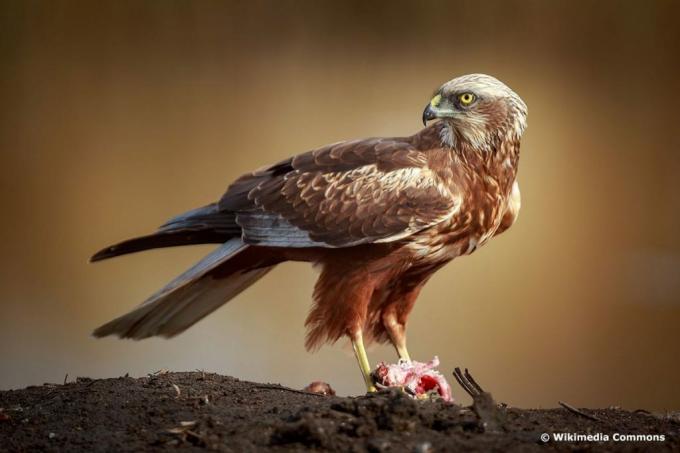
- Length: 48-56 cm
- Wingspan: 115-130 cm
- Weight: 400-670 g
- Plumage: females dark brown with a yellow head, males rust brown with a greyish head
- Diet: songbirds and water birds, their chicks and eggs, small mammals, fish, frogs, lizards, large insects
- Distribution: migratory bird, in Germany in larger bodies of water or in fields near bodies of water
- Propagation: Ground brooder in reed or reed stands, lays four to five eggs
Montagu's Harrier (Circus pygargus)
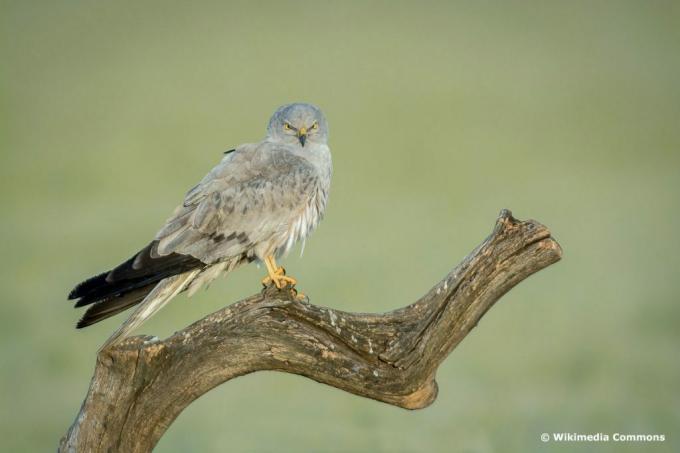
- Length: 43-47 cm
- Wingspan: 105-130 cm
- Weight: 227-445 g
- Plumage: Males predominantly gray, black wing tips, blackish horizontal stripes on the wings, females rather brownish in color
- Diet: rodents, birds, insects
- Distribution: migratory bird, inhabits heaths and fields, river valleys and moors
- Propagation: Ground brooders in meadows, moors, but also grain fields, lays three to five eggs
Falcon (falco)
The falcons have a hook-shaped upper beak with a point, the falcon tooth. Due to the large eyes and a very high mobility of the head, they have a very extensive field of vision. Unlike birds of prey, they do not build their own nests. They use rock hollows or other bird nests.
Kestrel (Falco tinnunculus)
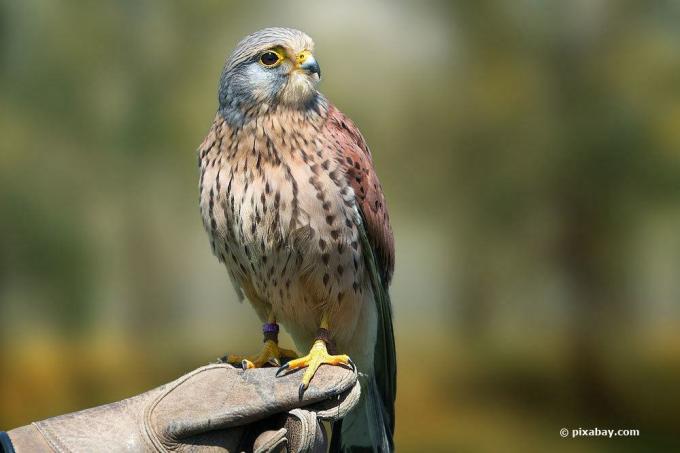
- Length: 33-38 cm
- Wingspan: 65-82 cm
- Weight: 160-290 g
- Plumage: male head gray, upper body reddish brown with black spots, tail dark brown, underside lightly speckled; Female with brown head, upper body patches enlarged into ribbons, underside darker
- Diet: rodents, mostly birds in cities
- Distribution: partly migratory birds, second most common bird of prey in Germany, also in cities
- Propagation: Rock breeders, also in buildings (name!), Lays three to six eggs
Peregrine falcon(Falco peregrinus)

- Length: 38-45 cm
- Wingspan: 90-105 cm
- Weight: 580-1090 g
- Plumage: upper side gray, underside white with transverse bands
- Diet: mainly birds, very skilled hunter in the air
- Distribution: resident bird, common in low mountain ranges and the Alps
- Propagation: breeds in rock faces and tall buildings, lays three to four eggs
Note: theshe native bird of prey is the fastest living creature on earth.
frequently asked Questions
Yes, the birds of prey also include vultures and secretaries, but they are not native to Germany.
Usually it can be seen with the naked eye and brief observation whether it is a bird of prey. This is due to the hooked beak, the forward-facing eyes, the sharp claws on the strong feet and the characteristic circling in the air when searching for prey.
For private individuals rather few. The protection of eyrie trees and nesting sites is important. Injured raptors are best reported to a raptor station, the animal shelter or the responsible hunter.

